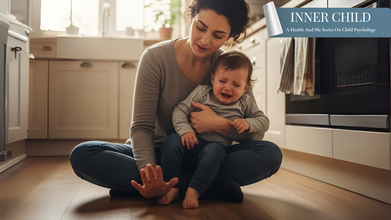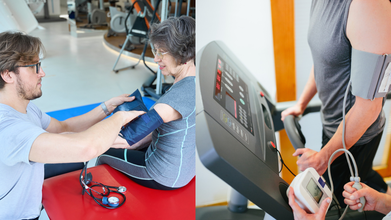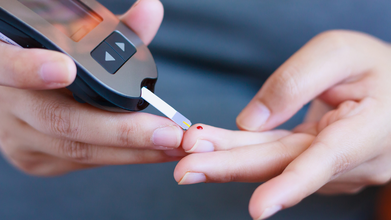- Health Conditions A-Z
- Health & Wellness
- Nutrition
- Fitness
- Health News
- Ayurveda
- Videos
- Medicine A-Z
- Parenting
Inner Child: ‘It’s Not My Fault’- Kids Learn Blame Even Before They Start Talking

Credits: Health and me
Inner Child’ is Health and Me's new mental health series where we deep dive into lesser-known aspects of child psychology and how it shapes you as you grow up. Often unheard, mistaken, and misunderstood, in this series we talk about the children’s perspective and their mental health, something different than you might have read in your parenting books. After all, parenting is not just about teaching but also unlearning.
A toddler stumbles, grazes their knee, and bursts into tears. The parent, instinctively, scoops them up and smacks the floor:
“Bad floor! Look what you did to my baby!”
The child’s sobs quiet down, their gaze turns to the floor. They feel seen, understood, and strangely soothed. But something deeper just happened—something psychological, something lasting.
In that split second, blame was introduced as a form of emotional relief. And it likely stuck.
Children begin learning the dynamics of cause and effect long before language kicks in. According to Dr. Charles Nelson, professor of pediatrics at Harvard Medical School and Boston Children’s Hospital, infants are “like little scientists,” constantly scanning their environments for patterns, reactions, and consequences.
By 12 to 18 months, toddlers can associate actions with outcomes. They may not have the vocabulary to explain what happened, but they are highly sensitive to how adults frame emotional responses. So when a child gets hurt and sees their caregiver express outrage—not at the pain, but at the object—the message received is, “Something caused my pain. I am not to blame. That thing is.”
This isn’t just comforting, it’s the foundation of an emotional habit that can echo well into adulthood.
Blame as a Comfort Mechanism
In those early years, children are overwhelmed by big emotions—fear, sadness, confusion—without the tools to process them. When adults shift those emotions outward by blaming an object (a toy, a table, the floor), it provides instant clarity.
Psychologist Dr. Lisa Damour, author of Under Pressure, explains, “Assigning blame feels good because it gives discomfort a direction. It gives fear an enemy.” It’s developmentally normal but the catch is, when repeated, this pattern teaches kids that blame isn’t just useful—it’s soothing and once something becomes soothing, it gets hardwired.
The “Inner Child” Never Forgot
Fast forward 20 or 30 years, you miss a deadline or a friend cancels plans or your partner calls you out on something you said. What’s your first reaction?
If it’s defensiveness, or a rush to find fault in someone else—you might be looking at the echoes of a pattern laid down in toddlerhood. This is the inner child at play, still trying to manage discomfort through externalization.
Neuroscience supports this, according to research from UCLA’s Brain Mapping Center, early emotional responses shape the amygdala and prefrontal cortex connections—the same regions involved in emotional regulation and threat assessment in adulthood.
What that means in simple terms, the emotional shortcuts we learn before we’re three… stick.
Why Makes Parents Do It?
This is not about bad parenting. Most parents who smack the floor when their child cries are doing it out of instinctive empathy and a strong urge to protect. Some may even be trying to distract the child from pain by redirecting their focus but that protection sometimes comes at a subtle cost: the child doesn’t learn how to sit with difficult feelings or how to self-soothe without blame.
Over time, if every distressing event is paired with an external villain, the child doesn’t just avoid pain—they avoid accountability, resilience, and emotional processing.
What Are Kids Really Learning?
When children consistently learn to blame something else for their emotions—whether it’s a toy, a sibling, or the weather—they’re more likely to:
- Struggle with frustration tolerance
- React with anger or withdrawal when criticized
- Develop a victim mindset in adulthood
- Avoid self-reflection or growth after failure
In clinical settings, psychologists refer to this as external locus of control—believing that outside forces dictate your emotional reality. It’s linked to higher anxiety, low self-esteem, and passive-aggressive tendencies in adults.
What’s the Alternative?
You can still be a comforting, empathetic parent or caregiver—without teaching blame. Here’s how:
1. Name the Emotion, Not the Villain
Instead of hitting the floor, say:
“That must have scared you.”
“You didn’t expect that. It’s okay to feel sad.”
Research in the Journal of Child Psychology and Psychiatry shows that naming emotions helps toddlers regulate them faster.
2. Normalize the Experience
Say: “Everyone trips sometimes.”
This sends the message that pain is part of life—not an unfair attack.
3. Comfort Without Redirection
Hold the child. Offer warmth and presence. You don’t need to distract them from pain—you’re teaching them that pain can be survived.
Can Adults Can Reparent Themselves?
If you notice yourself getting defensive, blaming others quickly, or feeling emotionally fragile when things go wrong—you’re not broken. You’re human but you’re also likely reenacting an old pattern from your early wiring. Therapists working with inner child healing often guide clients to pause before blame, and ask instead:
- What am I feeling right now?
- What am I afraid this means about me?
- Can I validate the feeling without blaming?
This small shift can be emotionally liberating—a way to rewrite the script we were handed before we could even speak.
When we hit the floor to stop a child from crying, we’re trying to comfort them. But sometimes comfort masks the deeper work of emotional education. Blame, when taught early, becomes an emotional reflex. But it’s one we can interrupt—with awareness, with language, and with love because one of the most powerful things we can teach a child is this, pain doesn’t need a villain to be real, it just needs to be felt and survived.
The Two-Word Blood Pressure Hack A British Heart Specialist Swears By

Credits: iStock
A senior British cardiologist has shared a clear two-word tip that he says can make a real difference to your blood pressure. Dr Amir Khan recently explained this advice while outlining five simple habits that can naturally bring hypertension under control, particularly during the winter months when heart risks tend to rise.
India continues to struggle with a heavy hypertension burden. Roughly one in three adults is estimated to have high blood pressure, yet many remain unaware of their condition, and even fewer manage it well. Doctors often warn that this lack of awareness, combined with poor control and gaps in long-term care, leads to serious complications such as heart attacks, strokes, and kidney disease. Since hypertension usually comes without symptoms, it has long been known as a silent killer.
Dr Khan highlights that a few lifestyle tweaks can go a long way, and his biggest message is built around a simple two-word mantra: “get moving”. He explained on Instagram that regular physical activity keeps blood vessels flexible and supports healthy blood flow. His advice is to pick any form of movement you genuinely enjoy and make it part of your routine.
How movement actually helps
Exercise reduces blood pressure by strengthening the heart, improving circulation, and reducing the strain on arteries. A stronger heart pumps blood more efficiently, which lowers the force exerted on blood vessel walls. Physical activity also opens up small blood vessels, helps manage weight, and reduces inflammation and stress hormones. All of these support healthier vascular function and better overall pressure control.
Doctors recommend a mix of aerobic activity, such as brisk walking, swimming, or cycling, along with strength training to support long-term heart and metabolic health.
Other helpful changes, according to Dr Khan
While movement is his main message, Dr Khan also lists four additional habits that support healthier blood pressure levels.
Reduce salt intake
He explains that those with high blood pressure need to be especially mindful of hidden salt. Adults should ideally stay around six grams a day, which is about a teaspoon. Much of this is already present in packaged or restaurant foods. Using herbs, spices, and fresh ingredients can help bring the total down.
Add more potassium-rich foods
Dr Khan encourages increasing potassium intake because it helps the kidneys flush out excess sodium. Foods rich in potassium include bananas, tomatoes, spinach, carrots, and kiwi. Adding these regularly can make a noticeable difference.
Avoid smoking and alcohol
He stresses that avoiding cigarettes and limiting alcohol is key for heart health. Smoking damages blood vessels and raises blood pressure, while alcohol can worsen both pressure and weight control.
Maintain a healthy weight
Keeping weight in a healthy range reduces strain on the heart and helps blood vessels function more efficiently. It also improves circulation and reduces the substances that cause vessels to tighten.
Dr Khan’s message is simple. Small and consistent lifestyle choices can noticeably lower blood pressure, and starting early makes a significant difference.
Sudden Cardiac Death Risk Far Higher in People With Diabetes, Reveals New Study

Credits: iStock
A new study in the European Heart Journal has shed light on a worrying trend. People living with Type 1 and Type 2 diabetes face a much higher risk of sudden cardiac death, and this risk contributes to a significant loss of life expectancy. The findings also suggest that the true burden of sudden cardiac death in the diabetes population has been underestimated until now.
A Higher and Earlier Risk Than the General Population
Sudden cardiac death refers to an unexpected loss of heart function, often triggered by a sudden electrical disturbance in the heart. While many people assume this happens mainly to those with known heart problems, earlier research has shown that a large number of cases occur in individuals without diagnosed cardiac disease. This means vulnerable groups like people with diabetes may slip through the cracks of current prevention strategies.
Also Read: Is There A Link Between Your Kidney Health And Other Chronic Diseases? Lancet Study Says Yes
People with diabetes already face a shorter lifespan compared to the general population. On average, a 30-year-old with Type 1 diabetes loses about 14.2 years of life, while someone with Type 2 diabetes loses around 7.9 years. A major share of this reduction is linked to cardiovascular disease, and the latest study estimates that sudden cardiac death alone accounts for 3.4 years lost in Type 1 diabetes and 2.7 years in Type 2 diabetes.
What the Danish Study Revealed
To better understand the scale of the problem, researchers examined a nationwide cohort that included every person living in Denmark throughout 2010. For those who died during that year, detailed information was collected from medical records, autopsy findings when available, and death certificates. Two physicians independently reviewed every potential sudden death to ensure accuracy.
The dataset included more than 5.5 million people. During the year, 54,028 deaths occurred, and more than 14 percent were sudden deaths. People with diabetes made up a significant portion of these cases. There were 25,020 individuals with Type 1 diabetes and 172,669 with Type 2 diabetes, with 97 and 1,149 sudden cardiac deaths recorded in each group.
People with diabetes who experienced sudden cardiac death tended to be younger and more often male compared with people without diabetes. They also carried a heavier burden of other medical conditions, including ischemic heart disease, heart failure, arrhythmias, kidney disease, and even mental health issues. A notable proportion of these patients had also been hospitalized for diabetes-related complications such as hypoglycemia, which researchers believe could play a role in triggering sudden cardiac events.
Numbers That Highlight the Gap
The incidence of sudden cardiac death in the general population was 105 per 100,000 person years. In contrast, it climbed to 394 for people with Type 1 diabetes and 681 for those with Type 2 diabetes. The relative risk was especially striking among younger adults. For example, people between 30 and 40 with Type 1 diabetes had more than twenty times the risk compared to those without diabetes.
A Clear Need for Better Prevention
The research team used multiple statistical models to adjust for factors like age and existing disease, and diabetes consistently emerged as an independent risk factor. The findings confirm that sudden cardiac death is responsible for a meaningful portion of life years lost in people with diabetes. They also point to a need for better screening, earlier management of cardiovascular risks, and more focused research into why this group is so vulnerable.
The Nordic Guide Of Staying Mentally And Physically Well Through Long, Dark Winters

Credits: iStock
Long winters are here, and Nordic countries are the most familiar with it. The winters there are long as dark. With little to no daylight and coldest temperature, people in the northern Europe and above the Arctic Circle have now learned to cope mentally and physically with the long winter blues. It begins as early as October and lasts till April for some.
The winter solstice on December 21 signals the shortest day and longest night of the year in the Northern Hemisphere. Even though daylight gradually begins to return after that, winter’s darkness continues to linger. Experts in Norway, Sweden and Finland say this is exactly the time when people need to be intentional about protecting their mood and energy. Here is how they suggest staying balanced, both physically and mentally, during the darkest months.
Keep Your Sleep and Social Rhythms Steady
Dr Timo Partonen, a research professor at the Finnish Institute for Health and Welfare, says that long, dark winters can disrupt the circadian rhythm. With limited daylight, the body struggles to reset its internal clock, which leads to restless nights and sluggish mornings. People may sleep more during winter but still wake up tired.
Partonen recommends using a dawn simulator, often called a sunrise alarm clock, which gradually brightens the bedroom and helps the brain ease into waking up. He also notes that people tend to withdraw socially during the winter and may become more irritable. Staying connected to friends and maintaining relationships can soften the impact of the winter blues. Pairing social time with exercise, such as going for a walk or a workout together, can also help maintain energy and mood.
Winter cravings for carbohydrates are common, especially in the evenings. These cravings can lead to weight gain of two to five kilograms a year, Partonen says, so regular activity becomes even more important.
Why Light Therapy Matters
Seasonal depression affects millions worldwide. Many people experience symptoms in the fall and winter that ease once spring arrives. Researchers have discovered that certain cells in the eye respond to blue wavelengths of light, triggering alertness and affecting mood. Sunlight is naturally rich in blue light, so shorter winter days can have a significant impact.
A University of Pittsburgh study found that people with seasonal depression were less sensitive to blue light during winter. This suggests a link between light exposure and mood. For severe symptoms, clinical care and antidepressants may be necessary, but Swedish pharmacology professor Christian Benedict says that light therapy is helpful for both diagnosed seasonal depression and mild winter blues.
Morning sessions with a light therapy box that emits around 10,000 lux can help reset the circadian rhythm and boost serotonin. Devices can range from seventy to four hundred dollars, and insurance may help cover costs for people diagnosed with seasonal affective disorder. Experts advise using a sunrise simulator along with a light therapy lamp before noon.
Embracing Winter as a Mindset
Ida Solhaug, a psychology professor at the University of Tromsø, says that mindset plays a huge role in handling the long winter. Instead of dreading the season, she encourages embracing it. This positive, practical approach is deeply rooted in Nordic culture.
She recommends enjoying indoor coziness with blankets and warm drinks, but also getting outside regularly. Even on cloudy days, a short walk can lift energy levels. Traditional winter activities like a Swedish fika outdoors, or even a cold plunge, can help people feel refreshed. Solhaug swims in the icy waters near Tromsø once a week and says it gives her a renewed sense of vitality.
Nordic culture also emphasizes dressing well for the weather. As locals often say, there is no bad weather, only bad clothing.
Finland’s President Alexander Stubb also shared his own winter survival advice: take an ice bath, follow it with a sauna, then repeat the cycle before heading out into the day.
If winter feels heavy, the experts’ message is clear. Look for light wherever you can find it, take care of your body clock and stay connected. Even in the darkest months, small daily habits can bring warmth and balance.
© 2024 Bennett, Coleman & Company Limited

